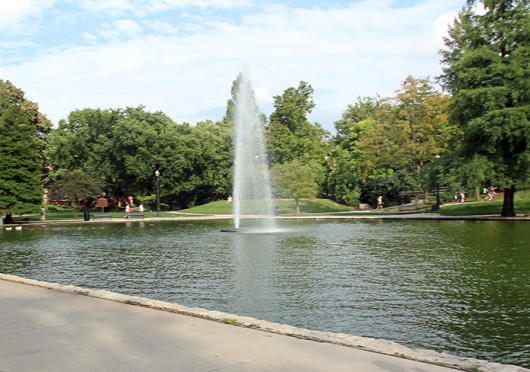
Mirror Lake is overflowing and leaking, but some OSU officials said research being done on the issue won’t affect the Mirror Lake jump tradition.
Credit: Shelby Lum / Photo editor
If you filled about two CABS buses with water and dumped them into the sewer on a daily basis, it would be roughly equivalent to what Mirror Lake spills into the local sewer system every day.
The cause: the lake’s continuous overflow and a recently discovered leak, said Ohio State spokeswoman for Administration and Planning Lindsay Komlanc.
In an effort to follow suit with campus’s ever-evolving sustainability plan and in part to discover the source of the leak, Mirror Lake is set to become subject to a slew of studies by EDGE Group later this month, senior vice president of Administration and Planning Jay Kasey said.
EDGE Group is a local firm of landscape architects and development consultants founded by former OSU football player and assistant vice president for business advancement Eddie George. The firm is set to help address several issues of the campus landmark, including options for fixing the leak, maintenance considerations and alternative sources to fill the lake, said Aparna Dial, director of OSU energy services and sustainability.
“It’s filled with drinking water right now, and the water source is Pomerene (Hall),” Dial said. “When we consider sustainability, we want to think about the cost to maintain and operate the lake in addition to looking at a good source — a more sustainable source for replacement — on a day-to-day basis.”
Komlanc said in an email OSU will be paying EDGE $24,000 to do the studies. The funds come from the President and Provost’s Council on Sustainability, which considers funding requests each year for various sustainability projects around campus.
As a resource, water is fairly abundant in this region of the world, but about one-third of the world’s population lives in water scarcity, Dial said. Conservation is an important part of helping to address the problem.
“On one hand, we have researchers trying to address these global problems, and we’re teaching our students to be global citizens. On the other hand, we are using drinking water to fill this lake, and not only are we using it, but we discovered it’s leaking and overflowing,” Dial said.
EDGE Group’s research, and possible resulting construction, might limit access to Mirror Lake in the near future, Kasey said, but he added that “it won’t affect the Mirror Lake jump.”
Jumping in Mirror Lake before the OSU football game against the University of Michigan is a university tradition, but it is not a university-sanctioned event. It is scheduled for Nov. 26 this year.
Kasey said the report from EDGE Group should be back by the end of December at which point a group of staff and students will discuss how to improve the lake. Changes will likely begin around January or February, he said.
“We do not want to make a prediction of what it may look like in the future. We all love Mirror Lake as it looks today,” Kasey said. “I can’t imagine how it could look better, but I imagine others can.”
Kasey said it was discovered recently the lake’s operations weren’t necessarily sustainable, considering the overflowing and the leaking were wasting drinking water.
“We became aware in the last year that the water consumption in Mirror Lake was getting to a point where, in almost anybody’s definition, we weren’t doing a responsible job of managing that water and what goes through our sewers,” Kasey said.
Some OSU students said they’re glad the university is working on fixing the problem.
“It’s good that they’re finally bringing someone in to take care of it because that’s a lot of water to lose and a really big waste of water, especially since as a campus we’re trying to be more eco-friendly,” said Emily Paetz, a third-year in human development and family science. “It’s not ideal that we’ve waited this long. It’s good that we’re finally doing something about it.”
Other students said having a firm look into the problem is a fair solution.
“Obviously, it should be fixed. I think that having someone to come in and look at it is the best solution. I hope we fix it as soon as possible,” said Hall Wang, a third-year in neuroscience.
Kasey added an important aspect of the project is keeping the campus icon intact.
“Our hope is that there are going to be some better solutions for how water is recycled through the lake and how water is claimed in places and used to fill the lake,” Kasey said. “We’re walking the walk as well as talking the talk of sustainability.”
Patrick Christ, a fourth-year in psychology, though, said that OSU not finding the problem until recently is an issue in itself.
“It’s kind of frustrating that they let the lake run for so long before they brought someone in,” Christ said. “It’s a huge step backward to waste all that water to just make something look nice.”


